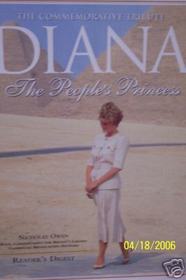"...Her death seemed to touch the chord that unites us all as people, as members of the vast and disparate human race, as partners in the great of nations. I have come to believe that there are several reasons why this is so. Diana had become, by the time of her death, an international superstar like no other before her. Although she was no longer married to the Prince of Wales, the heir to the throne, her superstar status was underpinned by her royal connections. To all intent and purposes she was regarded by her millions of admirers as fully royal, touched by thr indescribable regal magic. Another reason is that she was stunningly beautiful, In an age when technology enables pictures to flatter their subject unashamedly, Diana's good looks outdid the photographer's art. As Shakespeare's Cleopatra was described, Diana's entrance into a room 'beggared all description.'...
"Many of us in the media knew the Princess well. She had a great sense of humor, laughed easily and was unfailingly charming. But she could also be wilful and manipulative and was always ambivalent about how much of her royal status she wanted to use and when. Diana was no saint. She made silly mistakes and even grosser misjudgements. She was not infallible. But then niether are we. Part of her charm was her vulnerability. She was very human and it is now obvious from her many tributes to her, that she was capable of showing great humanity. When it was clear that she would never be Queen of England, Diana said, with what seems like wonderful prescience, that she wanted to be Queen of People's Hearts, The People's Princess. The response by the pepople to her death suggests that she achieved, in overwhelming measure, everything that she wanted to be.
"The undoubted value of this book lies in the simple fact that the images it contains will never die...the pictures of the glamous Princess; the pictures of her with her boys, the young Princes, who she loved so much. And then there are those forever haunting images of her coffin arriving back from Paris and the panorama of scenes of her funeral on the day an entire nation stopped to pay its respects. These will be pointed at and talked about long into the twenty-first century.
"They show that in her short life, marked by pinnacles of joy and depths of despair, Diana, Princess of Wales, became an icon who captured the world's imagination as no other public figure of our time."
"Many of us in the media knew the Princess well. She had a great sense of humor, laughed easily and was unfailingly charming. But she could also be wilful and manipulative and was always ambivalent about how much of her royal status she wanted to use and when. Diana was no saint. She made silly mistakes and even grosser misjudgements. She was not infallible. But then niether are we. Part of her charm was her vulnerability. She was very human and it is now obvious from her many tributes to her, that she was capable of showing great humanity. When it was clear that she would never be Queen of England, Diana said, with what seems like wonderful prescience, that she wanted to be Queen of People's Hearts, The People's Princess. The response by the pepople to her death suggests that she achieved, in overwhelming measure, everything that she wanted to be.
"The undoubted value of this book lies in the simple fact that the images it contains will never die...the pictures of the glamous Princess; the pictures of her with her boys, the young Princes, who she loved so much. And then there are those forever haunting images of her coffin arriving back from Paris and the panorama of scenes of her funeral on the day an entire nation stopped to pay its respects. These will be pointed at and talked about long into the twenty-first century.
"They show that in her short life, marked by pinnacles of joy and depths of despair, Diana, Princess of Wales, became an icon who captured the world's imagination as no other public figure of our time."





